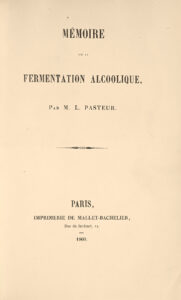/
* Style Definitions */
París, Imprenta de Mallet-Bachelier, 1860.
8vo de 106 págs. Medio cuero rojo, lomo nervado y decorado con florones dorados. Encuadernación contemporánê.
229 x 143 mm
First edition.
Pasteur’s first note on alcoholic fermentation, published in the Annales de Chimie et de Physique, is usually regarded as the first work in which he demonstrated that fermentation was not a purely chemical process, but needed the action of microscopic organisms.
“Pasteur established that alcoholic fermentation invariably produces not only carbonic acid and ethyl alcohol- as was well known – but also appreciable quantities of glycerin and succinic acid as well as trace amounts of cellulose, fatty matters and indeterminate products. On the basis of these results, Pasteur emphasized the complexity of alcoholic fermentation” (DSB).
Louis Pasteur (1822-1895) was “a chemist by training and profession [who] in a career of intense and brilliant work, rose to eminence in the fields of immunology, medicine and public hêlth. Biological chemistry and the food and silk industries owe him eternal gratitude” (Dibner).
Precious copy preserved in its contemporary binding in half-shagreen.
Ver menos información

